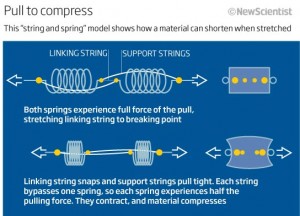Metamaterials, Negative Compressibility Rewrite Physics
After living on Earth for a number of years, you start to be able to confidently predict the way certain objects will behave when interacted with; but what if there were exceptions? What if the laws of physics that have been governing our lives for milenia were meant to be broken?
“We’ve gone almost as far as we can with high-strength materials. The next phase has to be materials that do completely different things.” -Prof. Christoper Smith, University of Exeter
Metamaterials
Metamaterials are artificial materials engineered by man to exhibit behaviors unlike anything found in nature. Metamaterials have shown the potential to yield sensational inventions such as optical computers, super microscopes, and invisibility cloaks. In this case, Professor Adilson Motter and Zachary Nicolaou from Northwestern University have designed a metamaterial that possesses what is called negative compressibility. Negative compressibility means that when force is applied to an object, the opposite effect of what is naturally expected occurs. If you exert force on such an object, attempting to compress it, it will spread apart. If you pull it apart, it will contract on itself and become smaller. The natural comparison to the phenomenon would be a Chinese finger trap.
Negative compressibility has been studied for over a decade, but it was believed that such a material could not exist, as it’s characteristics would be physically unstable. Motter and Nicolaou are the first to theorize a realistic way to achieve a stable form of negative compressibility.
Negative Compressibility: How does it work?
It’s understandably difficult to wrap your mind around, but essentially the design consists of four particles in a line. The two inner most particles intentionally have a weak force. Motter says that by pulling the particles apart, the attraction between the two outer most particles is dominant, and the material compresses. However, if the material is contracted on it self, the weak central charge is dominant, causing the particles to repel each other and the material to expand.
The design is still theoretical, but once realized, has some great potential to be implemented into the world around us. Motter says, “The most straightforward approach would be to use elements that have spring-like behaviour, such as rubber. Depending on how you assemble together little pieces of rubber, you could have a material that behaves in the way we are proposing here.”
A tug of war rope with negative compressibility would be fun to watch, while a child booster seat of this type would be pretty handy. What other aspects of life could you see negative compressibility having an impact on?
Throughout human history, we’ve known certain facts: the sun revolves around the Earth, the world is flat, powered flight is impossible. Could the laws of physics we’ve grown so accustomed to be just another one of these factual delusions?
Comments
Tags: adilson motter, laws of physics, metamaterial, metamaterials, negative compressibility, rewrite physics, zachary nicolaou
Trackback from your site.



Comments (1)
Observer
| #
Well, it would be useful for mattresses and furniture that compress over time.
Reply